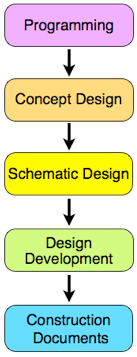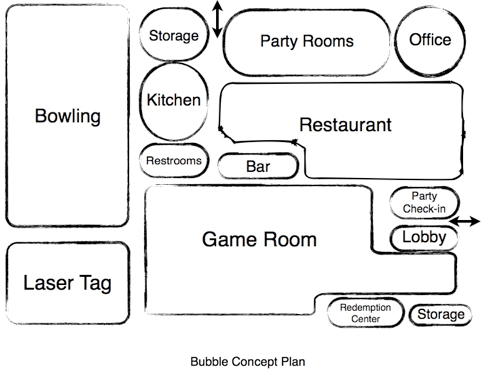
Vol. XI, No. 2, February-March 2011
- Editor's corner
- The importance of your business catering to families with children
- Location-Based Entertainment: How to Beat the Digital World at its Own Game
- Top tips for getting the design right the first time
- Foundations Entertainment University, April 26-28, Dallas, TX
- Make sure your business is found locally on Google and GPS maps
- In the news
- Recent blogs
- Our best on Twitter
- New Projects and Clients
Top tips for getting the design right the first time
Learn about the design process and tips for designing family entertainment centers (FEC) and other location-based entertainment.
 The design of a family entertainment center (FEC) or any other type of location-based entertainment (LBE) venue has a significant impact on its profitability. Design affects the guest experience, which in turn influences both attendance and per capita spending, and in turn, overall revenues. It also has an impact on operating expenses such as labor and utilities. Design also determines the overall facility cost, affecting return on investment. Getting the design right is critical to financial success. It is far less costly to get the design right the first time than to try to fix it later, or if it can’t be fixed, pay the financial consequences. Too often our company is hired by underperforming LBEs, where we find one of the primary root causes of their poor performance is due to their design.
The design of a family entertainment center (FEC) or any other type of location-based entertainment (LBE) venue has a significant impact on its profitability. Design affects the guest experience, which in turn influences both attendance and per capita spending, and in turn, overall revenues. It also has an impact on operating expenses such as labor and utilities. Design also determines the overall facility cost, affecting return on investment. Getting the design right is critical to financial success. It is far less costly to get the design right the first time than to try to fix it later, or if it can’t be fixed, pay the financial consequences. Too often our company is hired by underperforming LBEs, where we find one of the primary root causes of their poor performance is due to their design.
Design is a sequential process that goes through different design phases, each becoming the foundation for the next phase and each dealing with a greater level of detail. In reality, it is often difficult to determine exactly where some phases start and stop, as design is a continuous process.
Programming
This 1st stage of design, programming, is dependent on the findings from the project’s feasibility study for the mix of entertainment, play, leisure, dining and other building and site components and areas. The programming phase includes right sizing all project components based on the peak period attendance demand from the feasibility study. These include, among many, the capacity and throughput of attractions, amount of queuing, number of fixtures in the restrooms, size of the pizza ovens, number of seats in the restaurant, size of the gameroom and the size of storage areas. A written program schedule is prepared for every project component and area and their square footage or size requirements.
Concept Design
Here all the strategic adjacencies, the required relationships between all the project components, are determined and a bubble diagram is developed showing the relationship and placement of all components. Issues such as wayfinding; the logistics of deliveries, trash, running birthday parties and group events and other operational issues, ticketing, the location of such elements as the kitchen, seating, restrooms, attractions and the building and parking on the site are worked out.
Schematic Design
Floor and site plans, building elevations, building sections and attraction designs are started and outline specifications are prepared for the mechanical systems, site infrastructure, structural design and other major building and site systems. This is when safety and building codes start to be addressed. Basic menu development is required at this stage so the kitchen design can proceed.
Design Development
Drawings and details continue to be developed and refined. This includes detailing floor plans, interior and exterior elevations, theming, finishes, building sections, site grading and infrastructure improvements and producing drawings that show all building and site elements including stairs, windows, doors, structural plans, lighting, electrical distribution, electronics, mechanical systems, utilities, drainage and even landscaping. Attraction, entertainment component and kitchen design is refined.
Permit & Construction Documents
The final drawings and specifications that detail and provide all the information needed to obtain final pricing, the required building permits and documents for the construction of the project are created. This also includes the full design of all entertainment and attractions and specifications for all furniture, fixtures and equipment.
Although all phases are critical to getting the design right, programming and concept design will have the greatest impact. If something is not determined accurately during these phases, the final design will either not include it, it will be located in the wrong location or it will be the wrong size.

The design has a direct impact on a project’s cost. It’s all the lines drawn on the paper that determine cost. The only way to get the best project for your money is through early interaction with all members of the design, construction and management team with what is known as a concurrent design process.
The traditional design process is administered by an architect. It is sequential and linear, starting with floor and site plans. Then the design is passed down the line to specialists who, one by one, create the structure, attractions, lighting, electrical, mechanical, landscape, kitchen and other areas of design. Eventually the project ends up with the general contractor for bidding.
There are major problems with this traditional sequential process:
- The vision of the project is narrowed to include only architectural-type design considerations at the expense of the guest experience, operations, marketing and other factors.
- Each stage of design constrains the phase after it, often closing off design options that could improve the guest experience and reduce cost and operating expenses.
- The cost is unknown until the final bids come in. If the bids exceed the budget it takes time and costs more to redesign the drawings or in the rush to get the project started, the things that are easiest to change or delete get modified or omitted to save costs. Usually these are the things that matter most to the guest experience, things such as finishes, furniture, etc.
- The facility, operations and marketing are developed independently of each other instead as part of a cohesive whole.
Designing an LBE sequentially makes as much sense as, in the words of physicist David Bohm, gluing together the fragments of a broken mirror to see a true reflection. The result is that the LBE doesn’t provide the best guest experience, revenues, profit and return on investment.
Concurrent production overcomes these shortfalls. Concurrent production requires the assembly of a multidisciplinary cross-functional team that tackles the design simultaneously. The concurrent production team not only includes the design professionals, but also management and the general contractor and its key subcontractors. Everyone jumps in the sandbox at once. Rather than an architect driving the process, a producer oversees the entire process to assure it runs smoothly. The producer sees the big picture, but also has competency in all aspects of design, construction and management to assure that all the seemingly fractured parts come together as a seamless and financially successful whole.
Concurrent project production promotes flexibility and innovation. With everyone working together and seeing each other’s design perspectives, constraints that could reduce quality or costs are addressed and resolved.
One great advantage of concurrent production is that it allows for true value engineering rather than value engineering at the end of the typical sequential design process where the only things that can be engineered out at the last minute are those things that create the greatest value to the guests. The contractor and its subcontractors are part of the production team to not only give input on the most economical way to design the project, but also to constantly be updating a cost estimate to assure the final design ends up within budget.
Concurrent design also produces the most consistent brand identity, as all components of the brand identity, not only those applicable to the physical facility, can be developed simultaneously so they can be fully coordinated.
For sustainable design, especially if LEED (Leadership in Energy and Environment Design) certification is sought, a concurrent design (called integrated design with LEED projects) is essential, as everything affects everything else in design, so to achieve the desired results, everyone must work together at once.
So what does all this mean to a LBE developer? Here are some tips:
- Make sure you have a good feasibility study that projects attendance, peak period demand and per capita expenditures so the attractions and all site and building components will be properly sized.
- Use consultants and designers who are experienced with the type of entertainment project you are developing as you are designing a business and the physical design impacts the business’ success. Local architects are not knowledgeable on all the special considerations that go into a successful LBE design.
- Use consultants and designers who have no biases or conflicts of interest because they sell equipment or they receive commissions or referral fees from suppliers.
- Use concurrent design with everyone at the table throughout the entire design process.
- Make sure an experienced female commercial interior designer is involved and has a major role. Architects are trained to understand the technical aspects of design. Most are men who take an exterior perspective of projects. Interior designers are trained to deal with the psychology and emotional character of interior space. Women see the world through women’s eyes. That viewpoint is completely different than through men’s eyes. Women will be responsible for making the majority of decisions to visit the LBE unless it is one designed especially to appeal to males.
- Involve a contractor on the design team from day one. You will end up with a lower cost project with the contractor and its subcontractors value engineering as design progresses versus following the traditional design process of first fully designing everything and then putting the design out for competitive bid.
- Follow the sequence of the design process. Trying to skip phases to speed things up will only result in a flawed design.
- Good design takes time. There needs to be some processing time to think about things. Don’t try to rush it, as opportunities will be missed.
- Remember, you are not the customer, so don’t let your personal viewpoints and opinions drive the design process.
- Most of all remember the entire reason for developing a LBE is to create a great guest experience. It is the experience that results in attendance and per capita spending and, in turn, profits. It is easy to get caught up in all the details of design and lose sight of what the design needs to create. Stay focused with a laser on the sight of the forest, the guest experience, throughout the design process while also designing the trees.
Vol. XI, No. 2, February-March 2011
- Editor's corner
- The importance of your business catering to families with children
- Location-Based Entertainment: How to Beat the Digital World at its Own Game
- Top tips for getting the design right the first time
- Foundations Entertainment University, April 26-28, Dallas, TX
- Make sure your business is found locally on Google and GPS maps
- In the news
- Recent blogs
- Our best on Twitter
- New Projects and Clients


